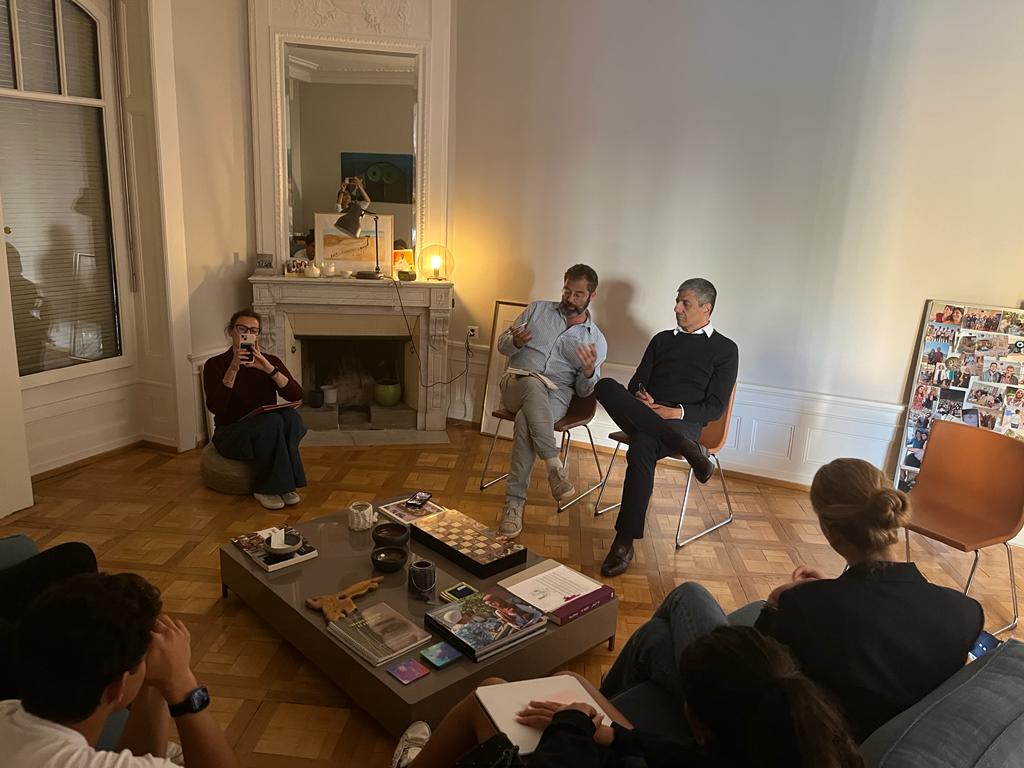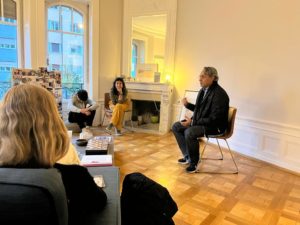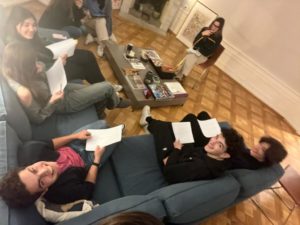“Let’s Talk About Peace” workshop
October-November 2023 Summary
October 10th Summary
The initial session of B8 of Hope & Philanthropic Adventures workshops began with a moment of acknowledging the tragic situation. Paola Genovese the founder of Philanthropic adventures explained the unfolding of the workshop and the purpose of the 3 year collaboration between Philanthropic Aventures and B8 of Hope. Paola also explained to the participants that we had decided to adapt the format due to the circumstances, transitioning from philanthropy to empathy as a theme. Despite this shift, the first session commenced with a presentation of B8 of Hope, outlining our mission and identity. Karim and David, two of the co-founders, shared their personal story of friendship as an Arab and a Jew growing up in Geneva and then becoming partners in B8 of Hope. Subsequently, we delved into a (as much as possible) balanced overview of the historical facts surrounding the Israeli-Palestinian conflict. The session also involved reflection on meaningful sentences that guide the work of B8 of Hope.
.

October 17th Summary
 Amidst the pain and horrors of the past few weeks, B8 of Hope is continuing on the pursuit of healing, learning, and empathy building. At our home base in Geneva, we held our second joint session with Philanthropic Adventures. A group of local high schoolers have committed to eight-weeks of learning about peace-building Israel and Palestine and being voices of change and empathy in their generation.
Amidst the pain and horrors of the past few weeks, B8 of Hope is continuing on the pursuit of healing, learning, and empathy building. At our home base in Geneva, we held our second joint session with Philanthropic Adventures. A group of local high schoolers have committed to eight-weeks of learning about peace-building Israel and Palestine and being voices of change and empathy in their generation.
 At this session, we watched the powerful movie “Les Guerrières de la Paix” (Warriors for Peace featuring a grantee movment of B8of Hope’s Women Wage Peace) which showed our students the challenges and power in being a peace activist. They learned about the important people behind Women Wage Peace, including young women not much older than they currently are. In light of all that is occurring, this screening was particularly powerful. In the face of adversity, when the world is expecting Israelis and Palestinians to hate each other, these women are choosing to find commonalities and choose empathy over continuing cycles of violence. It was inspiring for all of the participants to see the refusal to allow hatred to define these women’s narratives.
At this session, we watched the powerful movie “Les Guerrières de la Paix” (Warriors for Peace featuring a grantee movment of B8of Hope’s Women Wage Peace) which showed our students the challenges and power in being a peace activist. They learned about the important people behind Women Wage Peace, including young women not much older than they currently are. In light of all that is occurring, this screening was particularly powerful. In the face of adversity, when the world is expecting Israelis and Palestinians to hate each other, these women are choosing to find commonalities and choose empathy over continuing cycles of violence. It was inspiring for all of the participants to see the refusal to allow hatred to define these women’s narratives.
 Our group then transitioned into an impactful conversation about empathy, led by Ahmad Abu-Akel, a cognitive and social neuroscientist and currently a professor of psychopathology at the School of Psychological Sciences, University of Haifa. To begin, he posed the simple question: what is empathy? There was consensus that it is essentially the idea of putting oneself in another’s shoes; understanding their perspective. Professor Abu-Akel pushed the students to find what blocks people from being empathetic: the fear of the other, past trauma, mistrust, and egocentrism. He pointed to how it is more difficult for the oppressed to be empathetic than the oppressor, for they have grown up in an environment not conducive to empathy. Still, he pushed that we all have a duty to find empathy within ourselves; to look another human in the eyes and see them as a person, not a mere number or
Our group then transitioned into an impactful conversation about empathy, led by Ahmad Abu-Akel, a cognitive and social neuroscientist and currently a professor of psychopathology at the School of Psychological Sciences, University of Haifa. To begin, he posed the simple question: what is empathy? There was consensus that it is essentially the idea of putting oneself in another’s shoes; understanding their perspective. Professor Abu-Akel pushed the students to find what blocks people from being empathetic: the fear of the other, past trauma, mistrust, and egocentrism. He pointed to how it is more difficult for the oppressed to be empathetic than the oppressor, for they have grown up in an environment not conducive to empathy. Still, he pushed that we all have a duty to find empathy within ourselves; to look another human in the eyes and see them as a person, not a mere number or
.
October 31st Summary
B8 of Hope and Philanthropic Adventures held another stimulating session on empathy this week with our high school students. Expanding on the introduction to empathy last week by Professor Ahmad Abu-Akel, we delved deeper into understanding the challenges and power of empathy.
 To open the session, we watched a Ted Talks by Anita Nowak, a renowned professor of empathy. Nothing that “all the darkness in the world cannot extinguish the light of a single candle”, she discussed the power of empathetic action; the active participation that occurs when cognitive empathy (the logical, putting yourself in another’s shoes) and affective empathy (when you emotionally feel what another is going through) are combined. Our students had an interesting discussion on what they found most impactful. They thought the difference between empathy and pity was important and linked it to the difference between responsibility and guilt. There was also talk of the power of language, how Professor Nowak’s use of the term “empathic revolution” was a bit of an oxymoron—perhaps there is a more nonviolent word that could be used.
To open the session, we watched a Ted Talks by Anita Nowak, a renowned professor of empathy. Nothing that “all the darkness in the world cannot extinguish the light of a single candle”, she discussed the power of empathetic action; the active participation that occurs when cognitive empathy (the logical, putting yourself in another’s shoes) and affective empathy (when you emotionally feel what another is going through) are combined. Our students had an interesting discussion on what they found most impactful. They thought the difference between empathy and pity was important and linked it to the difference between responsibility and guilt. There was also talk of the power of language, how Professor Nowak’s use of the term “empathic revolution” was a bit of an oxymoron—perhaps there is a more nonviolent word that could be used.
 As was emphasized in Professor Nowak’s talk, empathy is just like a muscle. It must be trained and practiced, building it into a strong tool. Our students learned about 8 strategies to develop this ‘empathetic muscle’: cultivate curiosity (1), step out of your comfort zone (2), receive feedback (3), examine your biases (4), walk in the shoes of others (5), have difficult, respectful conversations (6), join a shared cause (7), and read widely (8). We saw that in practice with two organizations that B8 of Hope supports; Empathy for Peace and MEET. Empathy for Peace focuses on conflict transformation to develop empathy in the peace building process. MEET is an example of strategy 7, for it brings together Israeli and Palestinian students to work together on computer science and entrepreneurship development. These examples showed our students concrete examples of how empathy can be utilized in meaningful programs.
As was emphasized in Professor Nowak’s talk, empathy is just like a muscle. It must be trained and practiced, building it into a strong tool. Our students learned about 8 strategies to develop this ‘empathetic muscle’: cultivate curiosity (1), step out of your comfort zone (2), receive feedback (3), examine your biases (4), walk in the shoes of others (5), have difficult, respectful conversations (6), join a shared cause (7), and read widely (8). We saw that in practice with two organizations that B8 of Hope supports; Empathy for Peace and MEET. Empathy for Peace focuses on conflict transformation to develop empathy in the peace building process. MEET is an example of strategy 7, for it brings together Israeli and Palestinian students to work together on computer science and entrepreneurship development. These examples showed our students concrete examples of how empathy can be utilized in meaningful programs.
 The second half of our session was based on activities for the students to practice and understand their empathy. To learn to identify emotions, we began with a “mime it out” activity, where each student and adult picked an emotion out of a bag and had to act it out. While this activity drew a lot of laughs, it also helped us understand how we interpret facial expressions of others. The next activity was a drawing challenge, where each of us spent 5 minutes interpreting the same picture of a women standing alone in New York. We saw how some of the stories we created were similar, while others greatly differed—there are different perspectives when looking at the same situation. Next, we worked on active listening through a drawing challenge. The students were partnered up and sat back-to-back. One student had an image they had to instruct the other to draw. A fun activity, our students had to ask the right questions and be able to give and receive information in a sometimes-frustrating setting. Finally, we engaged in an open-mindedness activity, where the students were again paired up, and had to walk towards one another until they felt uncomfortable. This showed us all how different people have different levels of comfortability, and how this can change depending on who is participating. Overall, these activities helped our students bond, have fun, and understand empathy a bit better.
The second half of our session was based on activities for the students to practice and understand their empathy. To learn to identify emotions, we began with a “mime it out” activity, where each student and adult picked an emotion out of a bag and had to act it out. While this activity drew a lot of laughs, it also helped us understand how we interpret facial expressions of others. The next activity was a drawing challenge, where each of us spent 5 minutes interpreting the same picture of a women standing alone in New York. We saw how some of the stories we created were similar, while others greatly differed—there are different perspectives when looking at the same situation. Next, we worked on active listening through a drawing challenge. The students were partnered up and sat back-to-back. One student had an image they had to instruct the other to draw. A fun activity, our students had to ask the right questions and be able to give and receive information in a sometimes-frustrating setting. Finally, we engaged in an open-mindedness activity, where the students were again paired up, and had to walk towards one another until they felt uncomfortable. This showed us all how different people have different levels of comfortability, and how this can change depending on who is participating. Overall, these activities helped our students bond, have fun, and understand empathy a bit better.
.
November 7th Summary
On November 7th, our students participated in the fourth workshop with B8 of Hope and Philanthropic Adventures. Much of this session was focused on learning a hard skill: how to write a pitch. To begin, the students thought of words that come to mind when they hear “B8 of Hope”. These words included peace, empathy, dialogue, communication, development, and compassion.
After this initial group brainstorm, the students were then introduced to the idea of writing a pitch. To provide even more substance for the students to write their pitches, they first looked back at the previous sessions and wrote down all they had learned and taken from them. This was an opportunity for them to reflect on what has impacted them, and to think about how they would share this message with others.
The students continued to the next part of the session; writing a pitch. We talked about how a pitch consists of three main parts: the Hook, the Body, and the Wrap-Up. We discussed what makes a pitch successful, such as knowing your audience, having a catchy opening, and really communicating why B8 of Hope is important to them as an individual. Using all the ideas they had come up with, they spent time creating their pitch for B8 of Hope. They then presented their pitches to one another. All the pitches were great, with the students really focusing on that B8 of Hope brings a third option to conflict—instead of being one side or the other, a person can be pro-both sides; pro-peace.
We transitioned into thinking about how we can say thank you to Ben and Reem from Tech2Peace for all they had done during the workshop, and how to show our support to them in these challenging times. This is a chance for the students to actively engage in empathy-building, and acts as a closing activity for the workshop. Philanthropy is about more than just raising money; it is about giving time and energy to causes we support. The students brainstormed different ways to show their appreciation: a letter, a video, a photo montage. They decided to do a photo montage and spent the remainder of the session taking photos of each other throughout the B8 of Hope office.
While we do not have a session next week, the students will use that time to communicate with each other and work on this final thank-you project. It was hard to believe that there is only one session left, but we were so proud of all the work the students have done and will continue to do!
.
November 21sr summary
This Tuesday, we had our final session of joint learning with Philanthropic Adventures. To begin, our students completed their project to Tech2Peace. Working together, the students wrote, directed, and compiled a film, thanking Reem and Ben for all that they did during the workshop. They spoke of all the strength and respect they have for them, and how their work inspires them as young people. This video was then circulated to Reem and Ben
 For the second half of this session, we invited the student’s parents to join us. They were able to experience what the students have been doing these past five weeks. The students discussed some of the most impactful parts of the workshop: they are equipped to see conflict from multiple perspectives, learning to develop empathy as a muscle, and understand that often, situations are not as black and white as they may seem.
For the second half of this session, we invited the student’s parents to join us. They were able to experience what the students have been doing these past five weeks. The students discussed some of the most impactful parts of the workshop: they are equipped to see conflict from multiple perspectives, learning to develop empathy as a muscle, and understand that often, situations are not as black and white as they may seem.
The parents were then invited to take part in empathy building exercises that the students did a few weeks prior. They participated in the “creating an empathic picture” challenge, where they each created their own stories based on a picture of a woman coming up from a train station. It was interesting how compared to the students, who were finding more negative parts of the photo, most of the parents had a positive outlook. This demonstrated how based on our backgrounds and life experiences, we can see the same image from different perspectives.
 The parents then participated in the open-mindedness activity, where two parents were partnered together; person A and person B. Person A made all the decisions: person B walked towards them, and they told them to stop when they felt uncomfortable. Then, person A walked to person B and stopped when they felt uncomfortable. We saw how for parents, too, their bubble of comfortability changed depending on who was making the decisions.
The parents then participated in the open-mindedness activity, where two parents were partnered together; person A and person B. Person A made all the decisions: person B walked towards them, and they told them to stop when they felt uncomfortable. Then, person A walked to person B and stopped when they felt uncomfortable. We saw how for parents, too, their bubble of comfortability changed depending on who was making the decisions.
Finally, we engaged in an open conversation about the point of empathy. Some of the parents questioned if it was to make us un-opinionated—this led to a lively debate about the power of empathy. We ultimately deduced that while it is normal and okay to still hold opinions, empathy allows us to not see the “enemy” as inhuman. It allows us to have humanity in some of the darkest circumstances.
This was a wonderful ending to our empathy workshop. It meant a lot for students and parents to come together to discuss empathy and peacebuilding. We are so happy to have these students now joining our network of NextGen B8 of Hope and can’t wait until the next time we get to work with them!


